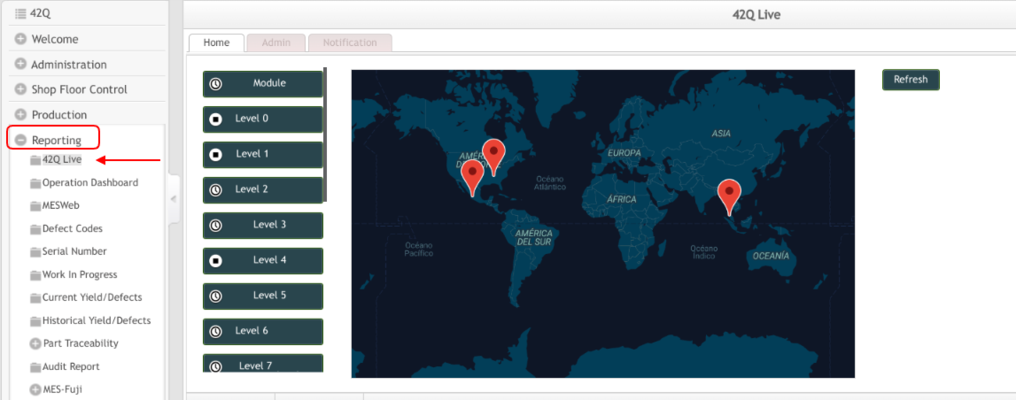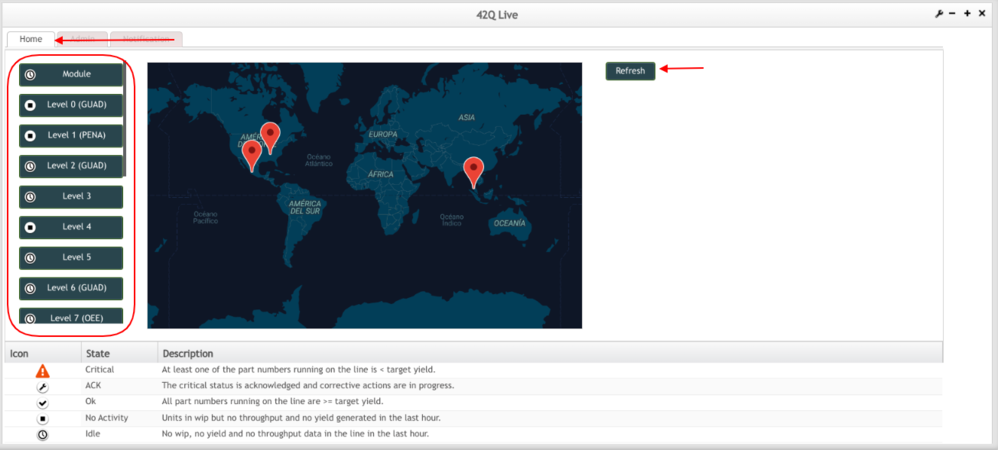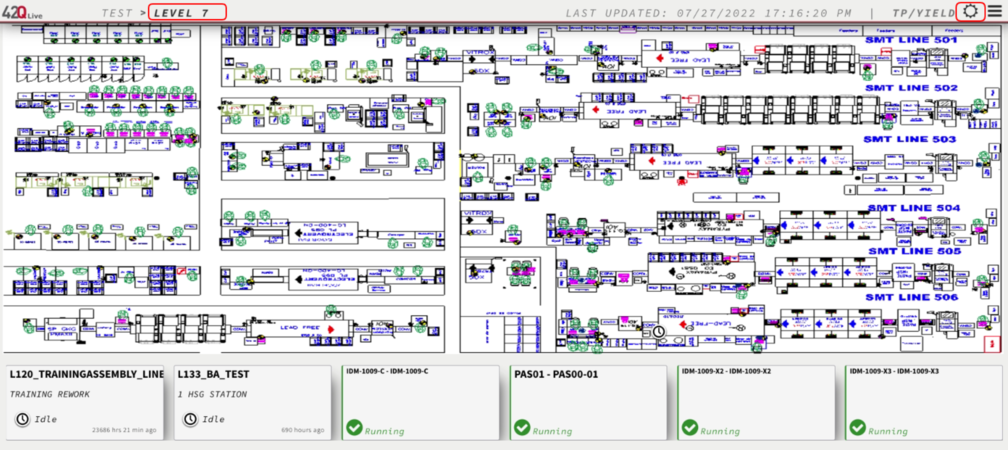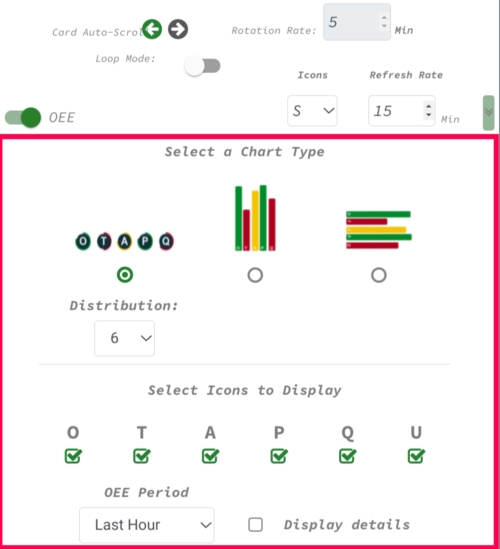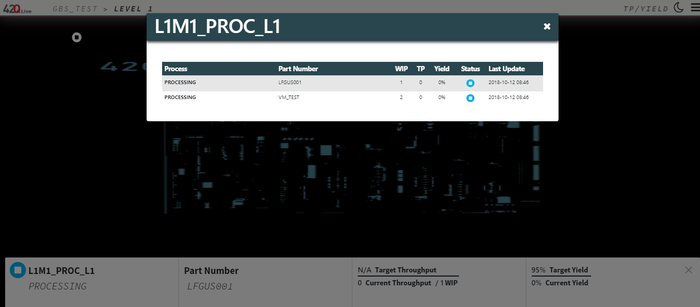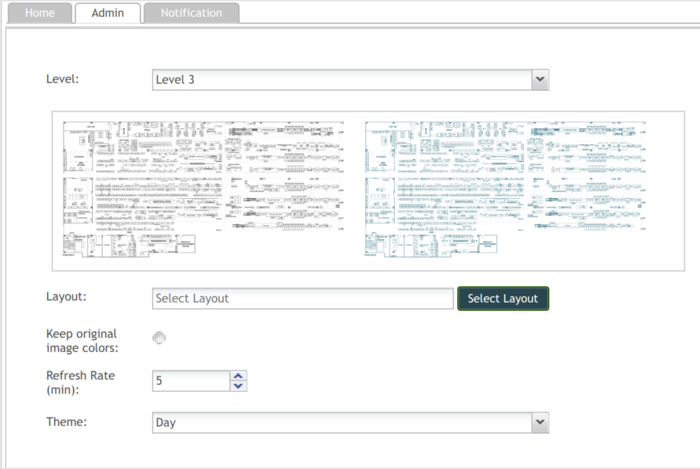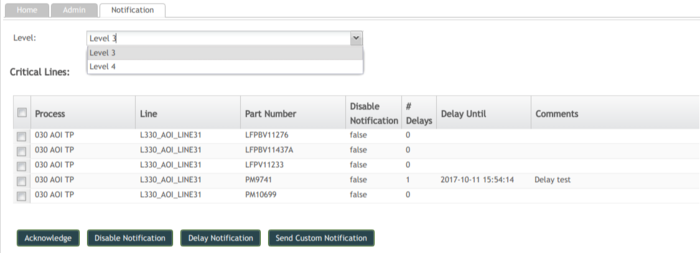42Q-MES0113-C 42Q Live
42Q Home > Reporting > 42Q Live
Contents
Introduction
42Q Live provides users a view of data reports to gain insight into critical lines on the shop floor. The 42Q solution gathers yield percentage data to determine the line’s status based on the configured target yield. If the line’s current yield is lower than its target yield, the line’s status will change to critical. Being able to view this information in an intuitive monitor layout increases plant visibility and ensures that issues can be addressed quickly as they arise.
Prerequisites
- Shop Floor ID defined in Shop Floor ID Maintenance
- All Locations are set up and defined in Location Maintenance
- All Devices set up and defined in Device Maintenance
- MFG Lines with all scanners and escalation levels have been set up MFG Line Maintenance
42Q Live
To access 42Q Live go to; Reporting > 42Q Live
Figure 1: Access
On the main page, users will be able to see three tabs, Home, Admin, and Notification, which will be fully explained below.
Home Tab
The Home tab is the main page in 42Q Live. Here, users can select the desired level from the list on the left side of the screen.
Note: In order to have levels available to select, they must be created and configured in the MFG Line.
Once created, the levels will be available on the Home tab of 42Q Live after a short interval. The bottom of the Home tab displays the key for the icons used in the layout monitor. TheseState Icons display on the monitor based on the configuration in MFG Line Maintenance.
To open the fullscreen layout monitor, select the desired level. The layout monitor for the specified level will open in a new tab.
Figure 2: Home Tab
Note: If the status of the levels has changed, use the Refresh button to update.
42Q Live Monitor
The 42Q Live Monitor displays line information for the selected Level of the floor. At the bottom of the screen, a carousel of information cards will display all of the configured lines for that level. Cards on the carousel can be selected to display detailed information about the selected line. In addition to the cards, the icons on the shop floor illustrate the line’s current status and can also be selected to view information about that specific line. Each card will display the Name and process associated with the line, as well as it is status and the last update. To view more detailed information about a specific line, select a card from the carousel. The card will expand to display the following information:
- The Name of the line and the Process
- Part Number
- The Throughput of the Line
- The number of items in WIP
- The Target Yield and the Current Yield
Note: The theme can also be changed to either Day or Night by selecting the icon in the Top Right Corner. The icon will display a moon if the layout is currently using the Night theme or the sun if it is using the Day theme.
Figure 4: 42Q Live - Day Theme
Figure 5: 42Q Live - Night Theme
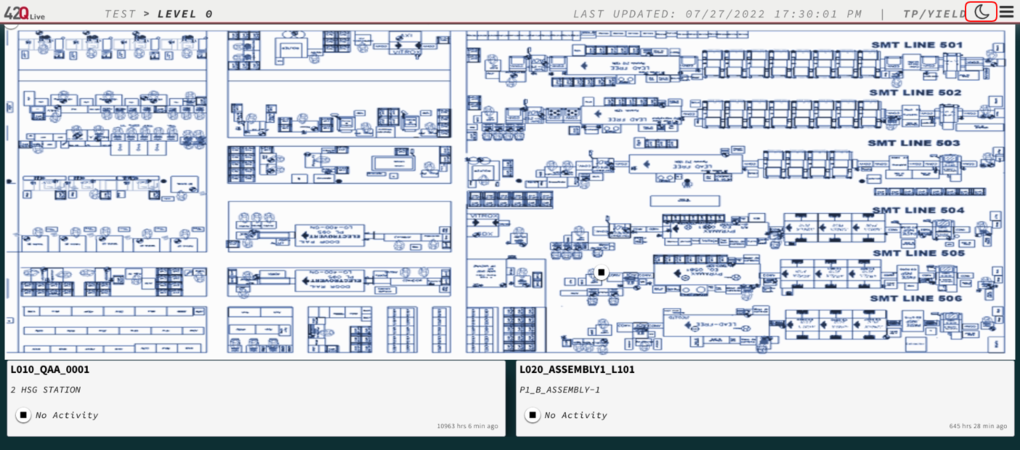
Note: The layout is refreshed at an interval specified in the Admin tab. Any changes made to the MFG Line configuration will refresh based on this interval.
Local Configuration
Thetop left of the monitor screen displays a navigation pane that is used to navigate between levels by selecting the desired level, as pictured in the figure above.
The Local Configuration can be viewed by clicking on the ![]() Configuration Menu icon.
Configuration Menu icon.
The Local Configuration screen is displayed:
Figure 6: Local Configuration
42QLive Local Configuration.png
From the Local Configuration the user is able to perform some actions as Download Saved Configuration, Enable/Disable Layers, Choose the size of the icons (small, medium or large), Update Refresh Rate, Change Card scroll to left/right, Enable/Disable Loop Mode, By default, the option is turned on, that means that it will continue scrolling consistently right to left, and just starting over with the first card placed behind the last card.
If the Loop Mode is enabled and the user clicks on an event bottom card before the last card is displayed, the rotation starts again. Once the first card is rotating again and the card can expand to display detailed information:
For OEE Cards, the OEE, TEEP, A, P, Q and up/down status and for TP/Yield Card, Line name, Process, and line status.
Once the first card is rotating again and the last card has not been reached, the card cannot be clicked. It does not expand to display details until the last card is reached and the complete cycle is done.
If the Loop Mode is disabled, the Monitor event bottom cards rotate to reach the end of the cards and it does not start again, it returns back to the first event card moving fast from left to right.
The bottom of the monitor displays a moving carousel of cards that provides information about the current status of the configured lines. Each card will display the Name and process associated with the line, as well as its status and the last update. To view more detailed information about a specific line, select a card from the carousel. The card will expand to display the following information:
- The Name of the line and the Process
- Part Number
- The Throughput of the Line
- The number of items in WIP
- The Targets Yield and the Current Yield
For OEE Cards, the OEE, TEEP, A, P, Q, and up/down status and for TP/Yield Card: Line name, Process, and line status.
For levels that contain an OEE layer, there exists an OEE Layer Configuration menu that can be expanded:
Figure 8: Configuration Drop-down Option
Users can expand more options settings to access the configuration options section by clicking the down arrow provided.
Once expanded, options are displayed regarding chart types, the number of columns, icons to display, time period, and additional details:
Figure 9: Chart Organization
Note: The Target Yield is automatically set at 95%.
Figure 10: Detailed information
To view the selected line’s history,
- Select the line to open the detailed view, then click on the card again. A pop-up window will display all of the processes and part numbers running on the line in order of priority.
The priority list is as follows:
- Critical
- ACK
- Hold
- OK
- Idle
- To return to the detailed view, select the OK button at the bottom of the pop-up window.
Figure 11: Expanded View
Admin Tab
The Admin Tab is used to set up the layout of the 42Q Live layout monitor. Here, the layout image is uploaded and all settings regarding the layout’s look can be selected for the desired level. The Admin tab contains the following functions:
- Level drop-down to select the level that the configuration will apply to.
- A preview box to preview the uploaded layout.
- Layout selection - Select the layout (image) to use.
Note: The recommended file size is or greater. Image files must be in PNG format. If the resolution is lower than the recommended size, an icon will display instructing the user to use a higher resolution image if available.
- Keep the original colors radio button.
- Refresh Rate(min)
- Theme drop-down: Day/Night.
Figure 12: Admin Tab
To set up a layout:
- Select a Level from the Level drop-down.
- Select the Select Layout button. The user’s computer file explorer window will display. Once a layout has been selected, a preview will display in the box above.
- If desired, select the Keep original image colors radio button.
Note: This feature will keep the original color scheme of the image. If left unchecked, the image color scheme will be converted to the color scheme of 42Q Live.
- Select how often, in minutes, that 42Q Live should refresh.
- Select either the Day or the Night theme from the Theme drop-down menu.
- Once all desired changes have been made, select Save.
Notification Tab
The Notification tab displays all critical lines for the selected level and is used for managing notifications for critical lines. The notification emails are configured when setting up the lines in MFG. Line Maintenance. Once the Level has been selected, the list of critical lines for that level will display under the Critical Lines heading.
The Critical Lines list displays the following columns:
- Process - The process associated with the line.
- Line - The line in critical status.
- Part Number - The Part Number associated with the line.
- Disable Notification - Displays either “true” or “false” depending on whether notifications have been disabled for the selected line.
- # of Delays - The number of times the notification has been delayed.
- Delay Until - The specified time that the notification will be delayed.
- Comments - Selecting a field under the Comments column will allow the user to enter a comment.
After selecting a line from the list, users have the following four options:
- Acknowledge - By selecting this option the user with the right permissions can change the status from Critical to Acknowledge. The status ACK (Acknowledge) will remain until the lines return to Ok status.
- Disable Notification - Users with the appropriate roles can select this to cancel the notification. This is useful if there is a planned outage and no one needs to be notified.
- Delay Notification - The Delay Notification option is used to delay the notification for a specified amount of delays before it is escalated.
- Send Custom Notification - This option is used to send a custom notification message to the selected escalation levels. Selecting the Send Custom Notification button displays a pop-up window.
Figure 14:Custom Notification pop-up window
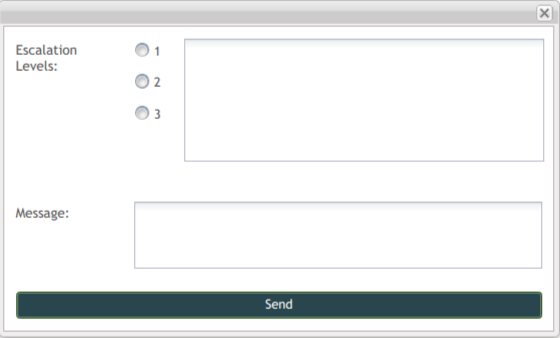
To send a custom notification:
- Select the desired escalation level from the Escalation Levels radio button. When an escalation level is selected, the email addresses associated with that level will display in the field to the right.
- Enter the message to be sent in the Message field.
- Select Send. A “Success” pop-up message will display if the notification was sent successfully.
